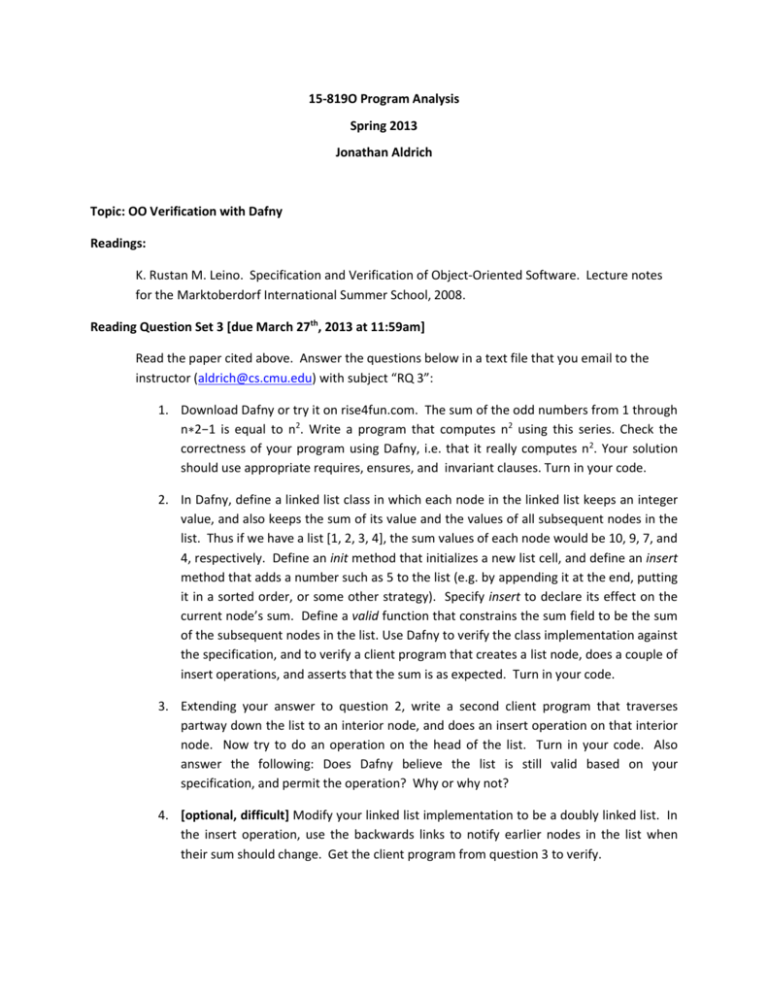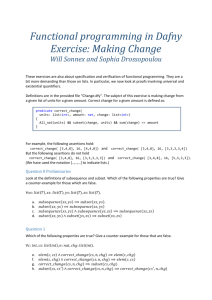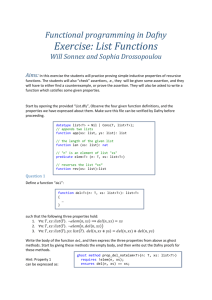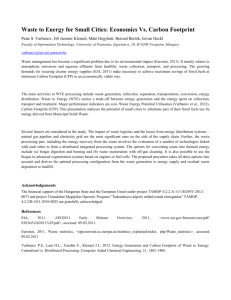rq3-dafny - School of Computer Science
advertisement

15-819O Program Analysis
Spring 2013
Jonathan Aldrich
Topic: OO Verification with Dafny
Readings:
K. Rustan M. Leino. Specification and Verification of Object-Oriented Software. Lecture notes
for the Marktoberdorf International Summer School, 2008.
Reading Question Set 3 [due March 27th, 2013 at 11:59am]
Read the paper cited above. Answer the questions below in a text file that you email to the
instructor (aldrich@cs.cmu.edu) with subject “RQ 3”:
1. Download Dafny or try it on rise4fun.com. The sum of the odd numbers from 1 through
n∗2−1 is equal to n2. Write a program that computes n2 using this series. Check the
correctness of your program using Dafny, i.e. that it really computes n2. Your solution
should use appropriate requires, ensures, and invariant clauses. Turn in your code.
2. In Dafny, define a linked list class in which each node in the linked list keeps an integer
value, and also keeps the sum of its value and the values of all subsequent nodes in the
list. Thus if we have a list [1, 2, 3, 4], the sum values of each node would be 10, 9, 7, and
4, respectively. Define an init method that initializes a new list cell, and define an insert
method that adds a number such as 5 to the list (e.g. by appending it at the end, putting
it in a sorted order, or some other strategy). Specify insert to declare its effect on the
current node’s sum. Define a valid function that constrains the sum field to be the sum
of the subsequent nodes in the list. Use Dafny to verify the class implementation against
the specification, and to verify a client program that creates a list node, does a couple of
insert operations, and asserts that the sum is as expected. Turn in your code.
3. Extending your answer to question 2, write a second client program that traverses
partway down the list to an interior node, and does an insert operation on that interior
node. Now try to do an operation on the head of the list. Turn in your code. Also
answer the following: Does Dafny believe the list is still valid based on your
specification, and permit the operation? Why or why not?
4. [optional, difficult] Modify your linked list implementation to be a doubly linked list. In
the insert operation, use the backwards links to notify earlier nodes in the list when
their sum should change. Get the client program from question 3 to verify.
5. Consider the Dafny code for a doubly-linked list cell below. What is the problem with
the Valid() function, and why is it a problem for verification? Write an improved Valid()
function that does not have this problem, yet still ensures the list is linked up
consistently.
class DList {
var val:int;
var next:DList;
var prev:DList;
var footprint:set<DList>;
function Valid():bool
reads this,footprint;
{
this in footprint
&& (next != null ==> next in footprint && next.footprint == footprint
&& next.prev == this && next.Valid())
&& (prev != null ==> prev in footprint && prev.footprint == footprint
&& prev.next == this && prev.Valid())
}
}
6. Consider the partial Dafny code listed below, in particular the client method. The full
implementation of class C is not shown, but the important parts of the specification are.
a) Explain, using the definition of fresh from the Dafny paper, how Dafny knows
that c1 and c2’s footprints are disjoint.
b) Explain, using the relevant part of Figure 9 in the Dafny paper, how Dafny knows
that no objects in c1’s footprint changed when c2.increase() was called.
c) Explain, using an axiom defined in the Dafny paper, how Dafny knows that
c1.count() is unchanged after the call.
class C {
var footprint:set<C>;
function count():int
reads this,footprint;
{…}
function valid():bool
reads this,footprint;
{…}
method increase()
requires valid();
modifies this, footprint;
ensures fresh(footprint - old(footprint));
ensures valid();
ensures count() == old(count())+1;
{…}
// other methods and fields not shown
}
method makeC(x:int) returns (c:C)
requires x > 0;
ensures c != null;
ensures fresh(c);
ensures fresh(c.footprint);
ensures c.valid();
ensures c.count() == x;
{…}
method client()
{
var c1 := makeC(1);
assert c1.count()==1;
var c2 := makeC(2);
assert c2.count()==2;
c2.increase();
assert c1.count()==1;
}









